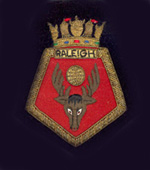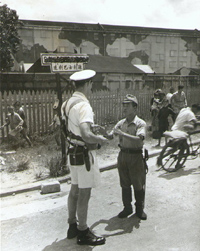Rallying to the Call
In 1940, 150 Canadians were selected from Naval Divisions for training and service on loan to the Royal Navy in WW II. They joined what became known as the Canadian Raleighite Scheme.
In the grim wartime days of 1940 an agreement was reached between the Canadian and United Kingdom Governments to train a number of Canadian recruits in Britain. Most were interviewed by Commander Eustace Alexander Brock.
The recruits travelled to the UK in six groups of twenty-five. Their ages ranged from 17 to 30, most being in their early twenties. A very few came with naval reserve experience, some with yacht club backgrounds while most, including many from the Prairies, had no association with the sea.
By November 1940 they had all arrived for basic training at HMS Raleigh, the training establishment at Torpoint, Plymouth, England. As Ordinary Seamen RCNVR they were then posted to various ships for mandatory three months seatime on the lower deck. After receiving their commissions these young men were then selected for sea duty in both RCN and RN ships. They saw service in various parts of the world in Combined Operations, Coastal Forces, corvettes, destroyers, cruisers and aircraft carriers.
Eighteen were lost on active service, including Lieutenant Robert Hampton Gray, VC, DSC, RCNVR of Nelson BC who was awarded a posthumous Victoria Cross – the last Canadian killed in action in World War II and the last time that decoration was awarded to a Canadian.
In addition to one Victoria Cross, Canadian Raleighites earned one Member of the British Empire (MBE), six Distinguished Service Crosses (DSCs), and twenty-two Mention-in-Despatches (M.i.D.s) during the war. Bill Burk, who served in Motor Torpedo Boats with Ross Campbell and Cam MacLachlan, was decorated with a DSC with two bars and two M.i.Ds. Edmond Jess received a DSC and three M.i.Ds in naval air actions ranging from destroying enemy shipping near Malta, to dive bombing operations in the Channel on D-Day, and against Sumatra and Okinawa in the Pacific war.
Raleighite naval aviators included Fred Bradley, Jean Paul Fournier, Edmond Jess, Hugh Tibbetts, George Willis, Harry Wilson, John “Jack” Diamond, James Gaunt, Hampton Gray, Alan Johnson, Arthur Sutton, and Ross Wilson. Six of this Fleet Air Arm group were killed in active service. Bob McRae serving in landing craft was shot up during the Dieppe Raid in 1942 and was taken as a POW until the end of the war.
A Roll Call by HMS Raleigh Mess Name and/or Number reveals the following 150 names:
MESS 16: Baillie, James W; Blake, Richard P; Cline, Roy W; Fothergill, Noel; Gracey, James M; Heffler, Donald F; Hicks, Douglas B; Landry, Pierre A; Macrae, Morson L; Mabee, Oliver B; McLean, Ian M; McGuire, Charles M; Monteith, Donald J; Nutter, Alexander; O’Connell, George F; Pendlebury, Edward L; Perry, Perry, Colin W; Pinchin, William H; Robarts, John P; Sheppard, William A.E; Stewart, C.N.R; Storey, William H; Templeton, Conn D; Tozer, Douglas H; Watson, Sidney R.
MESS 27 COLLINGWOOD: Anderson, A.R.K; Benson, Patrick C; Blair, David W; Bradley, Frederick W.H; Bugden, John B; Cruise, Henry R; Doheny, Hugh; Finley, Murray; Hicks, Anthony R; Jess, R. Edmond; McIIhagga, Liston B; McRae, Robert F; Metcalfe, C.John; Misner, J.Henry; Neilson, Walter I; Northgrave, Glen; O’Neill, Edward C; Pearce, Dennis F; Peacock, Thomas Stewart R; Powell, J. Allan; Rising, Edward; Sinclair, Robert M; Spears, John W; Sutton, Arthur M; Wilson, Harry P.
MESS 32: (This group came from Quebec and Ontario) Bartram, Howard F; Biggar Francis L; Brodie, Malcolm; Burk, Charles A; Carrique, John M; Derry, William C; Farmer, James; Joliffe, William E; Ker, Allan G; Leithead, James T; Lennie, Arthur F; Mills, Michael S; Muir, W. Wallace; Mullinger, Hugh H; Osborne, John D; Owen, Thomas F; Perrin, John D; Pidcock, Paul M; Scott, Bruce A; Stark, Basil; Stewart, John R; Webster, Harold W; Wilkinson, Arthur F; Woods, John R.

The Grumman F6F Hellcat, depicted here in Royal Navy insignia, was one of the best carrier fighters of World War II Photo courtesy of Stu Soward.
MESS 38 ESSEX: Bishop, T. Craig; Davies, D. Lloyd; Gaunt, J. Ernest; Guthrie, John M; Henry, E.P.T; Huston, Harris G; Lawson, Donald M; Macdonald, Alan A; Maclachlan, Campbell M; McGill, Donald G; McKinnon, N. Keith; Miedema, Louis; Moore, William F; Mowat, William H.M; Moyse, Robert J; Ripley, Ralph C; Shoup, Herman; Taylor, Douglas M; Tibbets, H.A.L; Venables, F.Ken; White, W.J.C; Willis, George A; Willis, Thomas A; Williams, Norman L.
MESS 108 MADDEN: Bayne, Gordon F; Botley, David M; Campbell, Ross; Charles, D’Arcy; Diamond, John; Finlay, Malcolm; Fournier, Jean Paul; George, James; Gray, R. Hampton; Johnson, Alan R; Kendall, John S; Marriot, Richard S; Mitchell, Fraser C; Monteath, James S; Moreland, William F; O’Grady, J.Walter de C; O’Rourke, John E; Petley-Jones, Evan; Qinton, John E; Rankin, James P; Robinson, Frederick V; Smith, Robert M; Sutherland, Donald; Wilson, Ross M; Young, Robert M.
FORETOP MESS: (Half came from Vancouver and half from Winnipeg) Bain, Douglas; Bird, John I; Brockley, Brian; Bulling, Larry M; Chaffey, Charles D; David, Fred; Douglas, Lionel P; Doull, John M; Fahrig, Robert; Fallis, Allen; Garlick, Stanley; Jones, Fred D; Kell, John D; Ker, Robert H; Lane, Stuart; Lea, William H; Lynch, William Peter; MacDonald, Charles; Maitland, Robert R; McLaughlin, John L; McCutcheon, John A; Munro, Charles S; Pipe, Gordon; Spearin, Cecil J; Square, Shath(Helier); Whittall, J.W; Wilson, J. Harris C.


 CFB Esquimalt Naval and Military Museum
CFB Esquimalt Naval and Military Museum CFB Esquimalt Naval and Military Museum
CFB Esquimalt Naval and Military Museum CFB Esquimalt Naval and Military Museum
CFB Esquimalt Naval and Military Museum